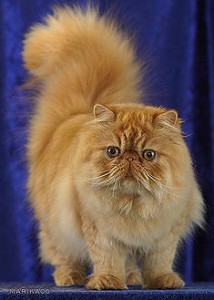All About the Persian Cat Breed

The Persian Cat is a longhaired cat characterized by its round face and short muzzle.
Its name refers to Persia, the former name of Iran, where similar looking cats live.
Persian cats were first bred by the English, and then mainly by American breeders after the Second World War.
In Britain, Persian cats are mostly reffered to as the ‘Longhair’ or ‘Persian Longhair’.
Selective breeding of the Persian cat carried out by breeders has created a wide variety of different coat colors, but has also led to the creation of increasingly flat-faced Persians.
A show-quality Persian has an extremely long and thick coat, short legs, a wide head with the ears set far apart, large eyes, and an extremely shortened muzzle. The breed was originally established with a short muzzle, but over time, this characteristic has become extremely exaggerated, particularly in North America.
Persian cats can be any color including pointed, golden, tortoiseshell, blue, and tabby.
Persian cats are the most popular breed in the United States already for many years and are very loved in other countries as well.
The Persian cat is generally a quiet cat. Typically placid in nature, it adapts well to apartment life.
A study found that Persians rated higher than non-pedigree cats on closeness and affection to owners, friendliness towards strangers, cleanliness, predictability, vocalization and fussiness over food.
The Traditional Perisan cat also known as Doll Face Persian is considered as a true breed of persian cat.
In the late 1950s a spontaneous mutation in red and red tabby Persians gave rise to the peke-faced Persian, named after the flat-faced Pekingese dog.
It was registered as a breed by the CFA but fell out of favor by the mid 1990s due to serious health issues. In fact, only 98 were registered between 1958 and 1995.
Despite this, breeders took a liking to the look and started breeding towards the peke-face look.
The over-accentuation of the breed’s characteristics by selective breeding (called extreme- or ultra-typing) produced results similar to the peke-faced Persians. The term peke-face has been used to refer to the ultra-typed Persian but it is properly used only to refer to red and red tabby Persians bearing the mutation. Many fanciers and CFA judges considered the shift in look “a contribution to the breed”.
Since Persian cats have long, thick dense fur that they cannot effectively keep clean, they need regular grooming to prevent matting. To keep their fur in its best condition, they must be bathed regularly, dried carefully afterwards, and brushed thoroughly every day. An alternative is to shave the coat. Their eyes may require regular cleaning to prevent crust buildup and tear staining.
Looking to adopt a Persian cat? Or are you a Persian cat breeder with persian kittens for adoption?
Check out our FREE cat classifieds – adopt a persian cat or offer one for adoption.
Source: http://en.wikipedia.org/wiki/Persian_(cat)
